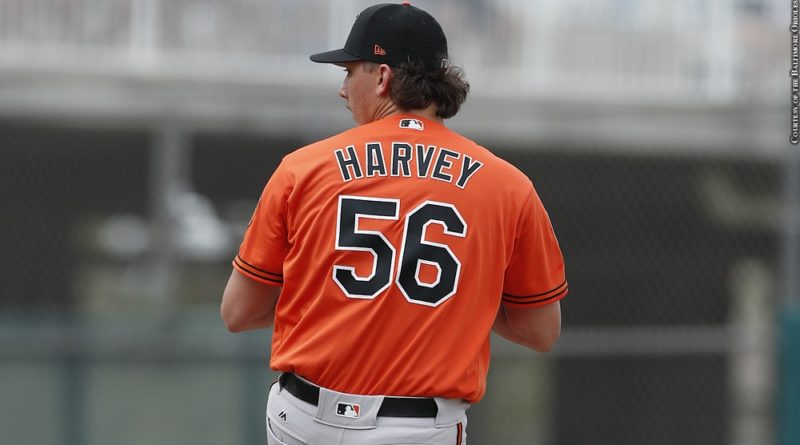The Orioles are bad, everyone knows they’re bad and there hasn’t been much to get excited about in what was always anticipated to be a lost season. There’s something to be said for fans latching on to veterans having strong seasons, like Jonathan Villar and Trey Mancini, or overlooked prospects producing at the major-league level, like John Means and Anthony Santander, or players looking to take advantage of an opportunity, like Hanser Alberto and Asher Wojciechowski.
But it’s a welcome addition, especially late in a cellar-dwelling season, to watch a more noteworthy prospect like right-handed pitcher Hunter Harvey and see what he can bring to the table.
A former top-100 prospect, Harvey’s struggles to stay healthy are well known. His injury list is long: a flexor mass strain in his right elbow, Tommy John surgery, a fractured fibula, sports hernia surgery and a dislocated shoulder. He went from being the Orioles’ No. 3 prospect in 2016, according to MLB Pipeline, to the team’s No. 15 prospect now.
Harvey is a former first-round pick out of high school and is only 24 years old. And because the injuries have limited his workload — he’s never thrown more than 87.2 innings in any minor-league season — there’s still a lot to learn about him. It’s almost amazing how little he’s pitched — a little more than 250 combined innings in parts of seven seasons. But after the O’s switched him from starter to reliever in June and moved him from Double-A Bowie to Triple-A Norfolk to the majors, one thing seems certain: he has the potential to be an outstanding relief weapon.
Making his major-league debut at Fenway Park Aug. 17, Harvey struck out two in a scoreless inning. He recorded his first major-league strikeout by throwing this 98 mph fastball by Christian Vazquez:
In his second appearance, at home against the Royals, he whiffed two more. Before freezing Jorge Soler with a 99 mph fastball, he completely fooled Whit Merrifield with this curveball:
Altogether, Harvey has thrown three scoreless innings and flashed two plus pitches: his four-seam fastball and his curveball. As a starter, his fastball sat in the 92-95 mph range. Now, he’s averaging 98-99 mph and showcasing the same biting breaking ball.
During his three outings, Harvey has averaged 98.6 mph with his fastball. To put that in perspective, only four other pitchers with a minimum of 50 four-seam fastballs thrown in 2019 have a higher average velocity. Harvey only needs to throw six more fastballs to qualify.
Harvey seems to relish the switch to the bullpen and the advantages of pitching in shorter bursts. He’s mentioned he wants to keep pitching in relief and that he doesn’t have to worry about setting batters up for future innings.
“You can come out and attack right away with everything,” he said after his first two outings with the O’s. “You don’t have to worry about keeping something from a hitter for next time. I’ve gotten confidence in being able to attack every time.”
Harvey also gained confidence when the Orioles gave him one of his weapons back before the season started. Like his father, Bryan, a former reliever for the Angels and Marlins who posted a 2.49 ERA and 2.63 FIP in 387 innings, Hunter has a splitter in his repertoire. But when he threw the splitter in his first major-league camp in 2015, it came as a surprise to then-manager Buck Showalter and he was ordered to stop doing it “because the staff didn’t want it to hurt his forearm.”
Recent research has shown that concern to be overblown, so it’s probably not surprising that a new regime led by general manager Mike Elias reversed course and gave the splitter back to Harvey, who prefers to throw a splitter instead of a traditional changeup.
Harvey was clearly excited to get the pitch back, while also not hiding his displeasure with how he had been treated the last few years.
“It’s nice — they’re kind of letting me be me,” Harvey said during spring training. “I’ve been babied the last couple of years with everything I’ve been allowed to do, so being able to just go out there and be normal — they’re letting me throw what I feel like I’m best with. That’s really nice.”
The splitter still needs some work, but it could become an effective second pitch against left-handed hitters if he locates it well enough.
Out of all of the Orioles’ prospects, Harvey is the highest-rated one to debut in 2019. And with rosters set to expand in September, a few others could join him. DJ Stewart (No. 23) and Dillon Tate (No. 27) are currently on the Orioles’ roster, but Ryan Mountcastle (No. 4), Austin Hays (No. 6) and Keegan Akin (No. 11) are options to join the big-league club soon, though none is a lock.
For now, fans will have to focus on Harvey. His appearances come as close to much-watch viewing as just about anything with the team. Harvey’s still on an unknown innings limit, and the O’s are reluctant to use him on back-to-back days as they try to navigate him through the season without an injury.
Harvey was drafted with the belief that he could become a frontline starter, but blossoming into an effective late-inning reliever would be more than acceptable. The Orioles need much better pitching across the board. Whether Harvey eventually returns to a starter’s role, starts receiving multiple-inning relief chances or sticks as a trustworthy one-inning guy, what matters is that he’s healthy and excelling. Harvey making opposing batters look silly is something fans could get used to.
Photo Credit: Courtesy of the Baltimore Orioles

